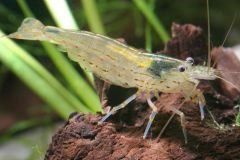Amano Shrimp vs Ghost Shrimp | What's The Difference?
Saw a medium-sized transparent freshwater shrimp at your local aquarium store? If you're not familiar with the differences between the two, it can be difficult to tell the ultra-popular Amano shrimp and ghost shrimp apart. But they're not the same, so it's important to be aware of which shrimp you're adding to your tank!
In this post, let's go into everything you need to know about the differences between Amano shrimp vs ghost shrimp. We'll have a look at what both are, how they differ visually, and how to figure out which is better for your aquarium.
Table of Contents
What is an Amano shrimp?
Scientifically known as Caridina multidentata (formerly Caridina japonica), the Amano shrimp's common name is a reference to the late legendary Japanese aquascaper Takashi Amano. It was Amano who first introduced these shrimp into the aquarium hobby after realizing their impressive algae-eating capacities.
To this day, aquarists still mostly keep Amano shrimp to help them control algae levels in their tanks. They don't reproduce easily in our aquariums and they can't be bred for fancy colors like dwarf shrimp, but they make for useful little janitors and it's fun to watch them go about their daily business.
Amano shrimp are naturally found in freshwater streams and rivers in Taiwan and parts of Japan. They're appreciated by aquarists not just for their algae-eating abilities, but also their friendly disposition and suitability for community aquariums. Amanos don't bother their tankmates, and because they're larger than dwarf shrimp, they're less likely to be eaten by them as well.
What is a ghost shrimp?
Ghost shrimp are a little more challenging to define than Amano shrimp, mostly due to confusion about their exact identity. The name "ghost shrimp" may be slapped on a wide range of translucent, humpbacked shrimp by aquarium stores. Some of these belong in brackish water, while others are aggressive and don't make a good choice for a community aquarium.
True ghost shrimp are medium-sized freshwater shrimp that belong to the genus Palaemon, of which a species called Palaemon paludosus (or grass shrimp, or glass shrimp) is the most common. These are usually sold as feeder shrimp and are very cheap to buy, but many aquarists also like to keep them as pets. Unlike "faux" ghosts, they work well in community tanks.
In this Amano shrimp vs ghost shrimp comparison sheet, we're referring only to Palaemon shrimp. Be sure to check you're not buying something like a whisker shrimp or Indian whisker shrimp (Macrobrachium), as these grow much larger and may even prey on their tankmates.
Amano shrimp vs ghost shrimp: Physical differences
Alright, so you got a shrimp. It's translucent and larger than a dwarf shrimp. Is it an Amano or a ghost? Don't worry, it's actually easy to tell the difference once you know what to look for!
The main physical differences between Amano shrimp vs ghost shrimp are:
| Amano shrimp | Ghost shrimp | |
| Size | Up to 2.5" | Up to 2" |
| Back hump | No | Yes |
| Pattern | Dots and dashes on the sides | Red antenna bands, possibly fine sprinkling of dots |

Amano shrimp vs ghost shrimp: Behavioral differences
Although both are shrimp and behave like shrimp, aquarists who have kept both Amano and ghost shrimp will know there are some differences in their behavior. One of these might strongly affect your decision when it comes to which species to go for: Amano shrimp are the superior algae-eating shrimp. While ghosts pick at algae, they're not nearly as voracious as Amanos.
Generally speaking, Amano shrimp can be considered more "relaxed" and less bold than ghosts. If you want lots of action in your tank, a group of ghost shrimp may be best for you—they're always zooming around and can get pretty feisty during feeding time. Amanos almost never stop foraging.
The relaxed attitude of Amano shrimp extends to their tankmates. Although they'll eat fish eggs, we've personally never really seen them go after fish fry, something that ghost shrimp will more commonly do. Ghosts may also be a little more prone to picking at long-finned tankmates' fins and antennae, so they're not the best to combine with fragile or very slow-moving species.
Did you know? While both Amanos and ghosts are challenging to breed in the aquarium due to both species passing through a larval stage before turning into real shrimp, it's easier to breed ghost shrimp than to breed Amano shrimp.

Amano shrimp vs ghost shrimp: Requirements
Both Amano and ghost shrimp are considered easy to care for and can be kept in aquariums of 10 gallons or up. It's best to keep them in groups of at least 3 (around 1 shrimp per gallon works well). Ensure the tank is densely planted/heavily decorated, so the shrimp can hide if they feel the need to.
Ghosts are tolerant of a wider range of water parameters and more forgiving of less-than-ideal water quality, but only if they're healthy to start with. Try to buy from a store that doesn't sell them as feeders, because cheap feeder shrimp may have been exposed to such bad conditions that their lifespans are severely limited.
Other than their sturdiness, the only real difference between Amano and ghost shrimp is in their diet. Your Amanos will like a mostly plant-based diet (although they do eat bugs and carnivore foods as well). Ghost shrimp are more omnivorous: they're the trash cans of the invertebrate world!
Conclusion
In conclusion, both Amano and ghost shrimp are highly popular in the freshwater aquarium hobby for a reason. They're easy and fun to keep, relatively docile, and helpful when it comes to picking at leftover foods and algae.
Amano shrimp are likely the right choice for you if you're looking for a champion algae eater to help you keep your tank clean. They're the calmer of the two, although they're by no means shy either.
Ghost shrimp are a bit more boisterous and ideal if you want a lively addition to your aquarium. Although they're not as good at eating algae, they do make a better choice if you're interested in trying your hand at breeding your shrimp.
MINI QUIZ ANSWER: The shrimp in the photo is an Amano shrimp. Note the straight back and the pattern of dots and dashes.



 Shrimp
Shrimp Fish
Fish Crab &
Crab & Plants
Plants Foods
Foods Snails
Snails



